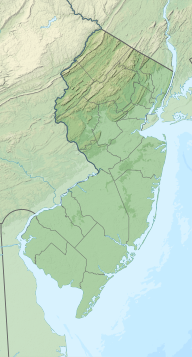Great Bay (New Jersey)
| Great Bay | |
|---|---|
 Islands near Great Bay during summer. | |
| Location | New Jersey, U.S. |
| Coordinates | 39°30′36″N 74°21′55″W / 39.51000°N 74.36528°W |
| Type | Bay |
| Max. depth | 43 ft (13 m) |
| Settlements | Brigantine, New Jersey |
Great Bay is located in southern
General
Great Bay averages about 1.5 meters (4.9 feet) in depth, and extensive areas of the estuarine substratum are covered with benthic algae and some vascular plants (seagrasses). Eelgrass (Zostera marina) beds are an important component of the submerged aquatic vegetation (SAV) community in Great Bay, generally where depths are 1 meter (3.3 feet) or less but, due to the slightly greater depth in Great Bay, these are not as ubiquitous as they are in the Barnegat/Manahawkin/Little Egg system to the north. Extensive areas (13.58 km2 (3,360 acres) of intertidal sandflats and mudflats occur in the bay, a result of the sediment load from the Mullica River and the movement of sand in through Little Egg Inlet.
Sealife
Finfish make up an important component of the bay's ecosystem. The bay provides an important nursery area for bluefish,
Fisheries investigations were conducted in the 1970s by the
Mullica River - Great Bay estuary
The Mullica River - Great Bay estuary habitat complex encompasses the entire Mullica River - Great Bay estuary and
The coastal salt, brackish, and freshwater marshes in the Mullica River - Great Bay estuary are extremely important to waterfowl, raptors, wading birds, and shorebirds. Raptors utilize the tidal marshes for nesting and for foraging throughout the year. Osprey nest on platforms in numerous locations throughout the salt marshes of this system. Significant concentrations of migrating and wintering waterfowl occur in the Mullica River - Great Bay estuary, with an average of over 12,000 waterfowl counted on midwinter aerial surveys.

